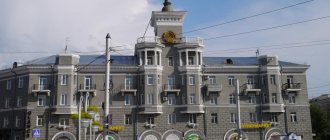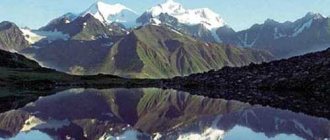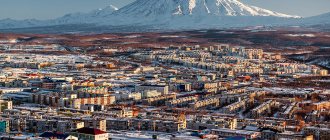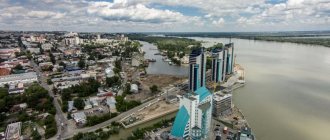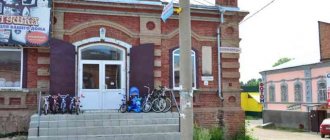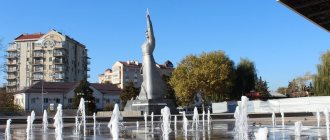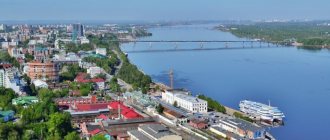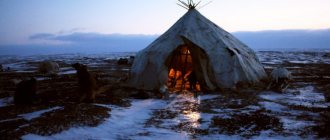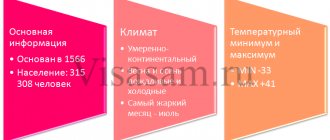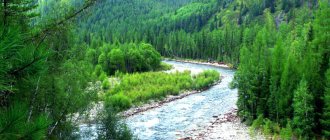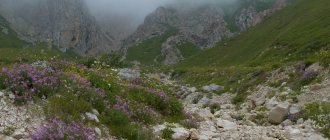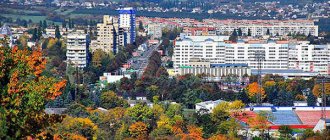- June 8, 2019
- Directions
- Lena Leto
The city of Barnaul (Altai Territory) is not a particularly popular destination for tourism, although it has its own history and a number of interesting attractions. Many people have a hard time imagining where it is and don’t know anything about its specifics. We will tell you about the capital of the Altai Territory, its history, geography, population and the most interesting sights.
Where is
Many residents of the European part of Russia, hearing the phrase “city of Barnaul,” ask the question: “Where is it?” And this is not surprising, because this city is separated from Moscow by 3 thousand kilometers. And the Altai Territory in Russia is not the most important and famous region. However, it is worth understanding that Barnaul is located in the south of Western Siberia, at the confluence of the Barnaulka River and the Ob. The city is surrounded on one side by the Ob River, and on the other by a ribbon forest.
Barnaul is the only city in Russia that is located on the banks of a large river, but only one bank of it is developed. The city has long dreamed of starting to expand towards Novoaltaisk, on the right bank, but these plans remain unrealized. The city is located in the forest-steppe zone, characterized by a predominantly flat landscape. The city area is also mostly flat with a few small hills. The nearest large city is Novosibirsk, 239 km away.
Train Station
The railway station in the city of Barnaul is located at Pobeda Square, 10. The station is open 24 hours a day. There is free car parking next to the main station building. The year the railway station was built is 1914.
The most popular train directions: Biysk, Cherepanovo, Kamen-on-Obi, Rubtsovsk, Bayunovo, Aleyskaya, Alambay, Tomsk, Karasuk, Rebrikha, Novosibirsk, Omsk, Moscow, Ridder, Abakan, Adler, Novokuznetsk, Kulunda, Tashkent, Karaganda. Suburban trains also operate from the railway station. In the station building, passengers can find a cafe, a hairdresser, a waiting room, a maternity and child room, and a medical center.
Climate and ecology
The capital of the Altai Territory has an unusual geographical location, which affects its climate. It is exposed to air masses from the Atlantic, the steppes of Central Asia and the Arctic Ocean. Only the Altai Mountains protect it from the eastern winds. Therefore, the climate in the Barnaul region is sharply continental. It is characterized by significant contrasts in weather. There are moderately snowy, frosty winters and warm, moderately humid summers. The region has a fairly high rate of sunshine - 2180 hours, for example, in Sochi it is 70-80 hours more. Barnaul has pronounced seasonal variations; there is a noticeable difference between spring, summer, autumn and winter.
The ecological situation in the city is quite satisfactory. Since in the capital of the Altai Territory there have been noticeably fewer industrial enterprises in recent years, the air has become cleaner. In winter, the situation is only worsened by private houses that are heated with coal, but there are fewer and fewer of them due to gasification. Transport is a major contributor to air pollution, but is not currently an environmental problem. But the situation with solid household waste is acute. All areas around the city are turning into unauthorized landfills, and this has a negative impact on the condition of the unique belt forest, which goes directly to the city. The forest is also threatened by logging, which is being carried out for the construction of residential buildings.
Mountaineering and trekking
While the central part of the region is predominantly a low-lying and flat area with water meadows, the outlying territories of the Altai Territory, on the contrary, provide athletes with wonderful opportunities for training and real ascents to the Altai Mountains. From their peaks you can see uniquely beautiful views of the surrounding landscapes, which belong to the systems of the West Siberian Plain and the Altai-Sayan mountain system.
For those who are not ready to take risks or do not have sufficient physical fitness, local tourist guides and specialized companies offer both group ascents to low altitudes and long walking routes along mountain ridges.
Administrative division
The banks of Barnaulka are considered to be the place from which the city began to grow. The Ob River in Barnaul became a natural barrier that the city did not cross. Therefore, the entire settlement was located on the left bank of the large river. The city is divided into 5 administrative districts: Central, Zheleznodorozhny, Oktyabrsky, Leninsky and Industrial. The city also includes 24 settlements: the villages of Yuzhny, Borzovaya Zaimka, etc. The local population of Barnaul also divides the city according to the traditional names of settlements or places that are included within the city. So, here you can hear such toponyms as Aviator, Solnechnaya Polyana, VRZ, Sulima, Cheryomushki.
Main streets of Barnaul
A map of Barnaul with houses allows you to see each street in detail and study in detail the objects located on them. In total, in the capital of Altai there are about 780 streets, 11 avenues, 10 tracts and 126 alleys. The largest of them:
- Lenin Avenue is the central thoroughfare of Barnaul, crossing three city districts, its total length from Kosmonavtov Avenue to Sq. them. V.N. Bavarina is 8.5 km away. Here are the most important government institutions (regional and city administration, prosecutor's office, regional court, Central Internal Affairs Directorate for Altai), secondary and higher educational institutions (medical university, ASU, Altai State Technical University, college of architecture and construction), the Dynamo stadium, as well as the Solar Wind park. .
- Kalinina Avenue is one of the main streets of the city, passing through the territory of Zheleznodorozhny and Oktyabrsky districts. Length from Kosmonavtov Ave. to Sq. Oktyabrya is about 5 km, the width varies between 11-36 m. The map shows that the part of the avenue between October and Tekstilshchikov squares is divided by an alley into 2 parts. Near the street there is the Transmash stadium, the economics department of the Altai Academy of Economics and Law, the regional state art museum and the youth theater. At the confluence with Lenin Avenue it forms October Square.
- Pavlovsky tract is one of the leading city directions, connecting the outlying areas and industrial zone with the central part of Barnaul. Then, following the map, it goes to the western regions of the region, turning into the P380 . Crosses the Zheleznodorozhny and Industrial districts, length is about 14 km. By 2025, with the implementation of the approved general plan, it should turn into a central highway. The road leading to the airport departs from the highway. Near the street there is a regional car market and several shopping centers.
- Malakhova Street is one of the main transport arteries crossing Barnaul in the meridional direction. It runs through three districts of the city, its length is more than 7 km, its width is about 30 m. Tram tracks are laid along almost the entire length of the street. Many five- and nine-story buildings were built along it, at the beginning is the Motor Builders House of Culture, in the middle part is the Institute of Reproduction and Genetics, and at the end is the Vlasikhinskoe cemetery. Forms a large interchange with the Pavlovsky Highway.
- Popova Street is an important transport route of the regional capital, which runs through the Leninsky and Industrial districts. It ends in the village of Novosilikatny, the length is about 10 km. Tram traffic is organized along the entire length. In the area of the street there is a perinatal center, regional and city children's hospitals, Dokuchaevsky market, as well as People's Square.
- Vlasikhinskaya Street - runs through the Industrial and Zheleznodorozhny districts, the length is more than 8 km. Nearby is the chapel of Dmitry Donskoy and the Volna shopping center, at the end it merges into the Pavlovsky tract.
Economy
The capital of the Altai Territory, its economic center in Soviet times was a fairly large industrial city. After the collapse of the USSR, many industrial enterprises ceased to exist, and the city began a slow decline. Today, the city has several large enterprises in the chemical, engineering and metalworking industries. There are also many successful agricultural processing enterprises in Barnaul. This is not surprising, because the Altai Territory is an agricultural region. But still, most of the population of Barnaul is engaged in trade. The city has many shopping centers and various commercial enterprises. Important for the city's economy is its convenient location at the intersection of some important transport routes. Barnaul has its own airport named after. G. Titov, a branch of the West Siberian Railway passes through the city.
In what region is Barnaul located?
The Altai mountain system gave its name to two Russian regions at once - the Altai Republic and the Altai Territory. While Gorno-Altaisk is the capital of the Altai Republic, Barnaul serves as the administrative center of the Altai Territory.
The Altai Territory has a common border with Kazakhstan and several regions of the Russian Federation, such as the Novosibirsk and Kemerovo regions, as well as the Altai Republic. The natural conditions of both regions are quite similar, as are their cultural traditions.
Separately, it is worth noting that, despite its border position, the Altai Territory is populated predominantly by Russians, who make up more than ninety percent of the population.
Population
At the end of 2022, 632 thousand people lived in Barnaul. Over the past couple of years, the number of residents of Barnaul has been decreasing. This can be explained by migration and natural decline. The capital of the Altai Territory is a fairly compact city, its area is 322 km². The population density is 1955 people/km². By gender, the groups of city residents are 55% women, 45% men. In terms of ethnic composition, the city differs little from many other settlements in the country. 95% of Russians live here, other nations are represented by groups of less than 1%.
Population gain or loss according to the census
The total and official population of the city of Barnaul, how many people live in it as of January 1, 2022, the number of people in each individual urban district and municipality, further in the second table.
| Year | Growth/decrease population city of Barnaul |
| 2017 | ↘633,301 people |
| 2018 | ↘632,372 people |
| 2019 | ↗632,723 people |
| 2020 | ↘632,391 people |
| 2021 | ↘631 124 people |
| 2022 |
City `s history
In the place where Barnaul is located today (Altai Territory), the first people lived back in the Stone Age. And even before the Russians appeared in this region, the Horde fortress Abaksha stood in this place, from which the Teleuts carried out devastating raids on neighboring settlements. But the real history of the city of Barnaul begins in 1730, when the miner Akinfiy Demidov organized the first settlement to build a copper and silver processing plant. When the plant started operating, people from all over the area flocked to the city. A whole group of St. Petersburg engineers and officers arrived to work at the plant. In 1748, the office of the mountain district was moved from Kolyvan to Barnaul. In 1771 it acquired the status of a mountain town. Barnaul is being built on the model of St. Petersburg. A library, a theater house, and a local history museum appeared. The city is becoming not only a mountainous city, but also a cultural and educational center of the region. But gradually mining fell into decline, and at the end of the 19th century Barnaul became a merchant city. When the railway came to the region, the merchants abandoned the plan according to which the line would pass through Barnaul. And this had a negative impact on the development of the city, which gradually lost its regional significance.
In 1917, a terrible fire occurred in Barnaul, which destroyed 40 city blocks. Restoration began only after the 19th century, already under Soviet rule. During the Soviet era, the city developed as a large industrial center; a number of factories opened here, some of which were evacuated here during the Second World War. After the collapse of the USSR, the city experienced difficult times associated with the closure of a large part of industrial enterprises. Today, the city is regaining its status as a major center of the agro-industrial sector; large residential construction is underway here, although difficulties in the development of the city remain, this is confirmed by the large number of citizens leaving.
National composition of Barnaul
| People | Number of people (%) |
| Russians | 629 271 (95,79 %) |
| Russian Germans | 6 172 (0,94 %) |
| Ukrainians | 5 301 (0,81 %) |
| Armenians | 2 690 (0,41 %) |
| Tatars | 1 547 (0,23 %) |
| Azerbaijanis | 1 488 (0,22 %) |
| Belarusians | 1 253 (0,19 %) |
| other | 9 261 (1,41 %) |
| Nationality indicated | 656 938 (100,0 %) |
| Total | 670 332 |
With the population of the city of Barnaul as of January 1, 2022, how many people live in this territory, people in municipalities and this locality, this territorial unit of the Russian Federation, that’s what we figured out here, we made our contribution to satisfying the requests of those interested in this statistical information .
Unfavorable days in 2022, difficult for health and well-being
Lunar calendar for hair cutting 2022, favorable days to cut hair
Culture
Like other large cities of the Altai Territory, Barnaul has a cultural life, although it cannot be called too vibrant and diverse. There are 4 state theaters and a philharmonic society in Barnaul, as well as several private small theaters. There are also several museums and art galleries in the city. The newest museum is the Mountain Pharmacy, a restored original 19th-century pharmacy. Also in Barnaul there is an unusual auto theft museum named after Yuri Detochkin and a museum of time, which contains household items from the 19th and 20th centuries. Children especially love the interesting museum of entertaining sciences “How so?” During Soviet times, Barnaul had an extensive network of cinemas. Today, this area is represented by the Kinomir chain and individual cinemas Pioneer, Matrix and Formula.
Barnaul - the capital of the world
Many cities have their own legends and myths, persistent stereotypes. There is one in the capital of the Altai Territory. There is a half-joking saying in the city: “Barnaul is the capital of the world.” It appeared during the period of perestroika. There are several versions of who first said it. But most of the local residents say that it was first heard in the song of the local rock band The 9. And later it was picked up by the writers the Orekhov brothers, who wrote fantastic stories and created a story called “Barnaul - the capital of the world”, the prototype of which was one of the characters musician of the group “9” Sergei Lazorin. This phrase became a kind of slogan for the avant-garde creative youth of the 90s. Now this expression has become part of local folklore and is popular among middle-aged Barnaul residents.
Attractions
When tourists plan to visit the Siberian city of Barnaul, they think about what they can see there. The first thing guests arriving by car see are large white letters in Nagorny Park a la Hollywood, as well as a long bridge across the Ob River. They also have a view of the old city, where the main attractions are concentrated. These include monuments of wooden architecture, in particular the House of the architect Lesnevsky, the house of the merchant Shadrin, the house of the architect Nosovich. The turn of the 19th and 20th centuries is represented by several beautiful stone mansions. The most interesting are the house of merchants Yakovlev and Polyakov, the Philharmonic building, the former People's House, and the city hall building. The Soviet period was the time when the complex of the city’s main street, Lenin Avenue, was formed. It is built up with buildings in the Stalinist Empire style. The most striking building of the Soviet period is the House under the Spire, which has become a real symbol of the city. Important architectural monuments are the city's cathedrals - Pokrovsky, Nikolsky, Znamensky.
Coat of arms
The coat of arms of Barnaul, dating back to the 1846 version, is made in the form of a French shield. It is divided into 2 parts horizontally. The upper one occupies one third of the area. It contains the governor's coat of arms. A white horse is presented on a green background. The animal is a symbol of power and strength in agriculture and mining.
At the bottom of the coat of arms on a blue background is a red smoking blast furnace. Flames can be seen from it. Near the metallurgical site there are rocks that embody silver smelting production.
The artistic composition was approved by the Decision of the Barnaul City Duma of March 27, 2009 No. 74.
Things to do
The city is not only architecture and monuments, but also parks and squares. In Barnaul, the beautiful Ob embankment has recently been decorated, along which you can take pleasant walks. The city is located on the border with a unique ribbon forest, where you can also take pleasant walks. You can also spend a few pleasant days in sanatoriums and holiday homes. The Altai region is famous for its beautiful nature and there are several excellent places to relax right within the city limits. You can also go for a walk to the arboretum, which is especially beautiful in the spring, when many varieties of lilac, apple and cherry trees bloom.
Tourism and sports in Altai
The nature surrounding Barnaul contributes to the development of active recreation associated with cross-country skiing in the winter and long walks over rough terrain in the summer. The demand for active pastime prompted one of the Barnaul companies to build a special track in Ribbon Bor. The length of the route is twenty-five kilometers, and it is designed in such a way that all athletes feel comfortable and safe when skiing. It starts at the Dynamo stadium and ends there.
Barnaul, where the Health Track is located, has thus become one of several cities where new trails and tracks have been built for runners and skiers. However, it is not only skiing that attracts travelers and sports tourism enthusiasts to Altai.
